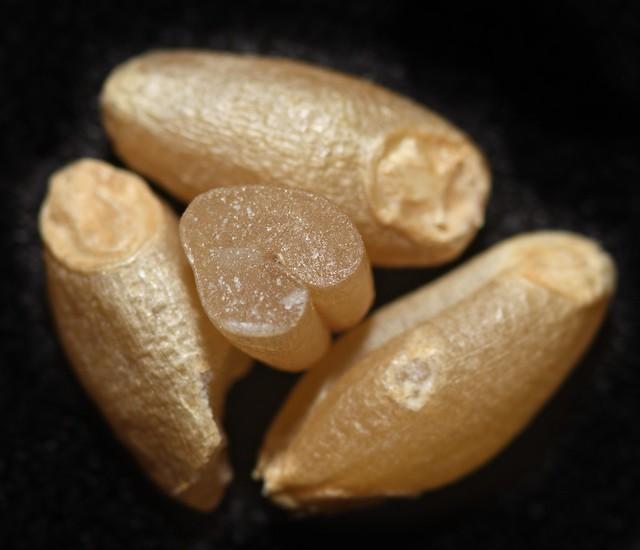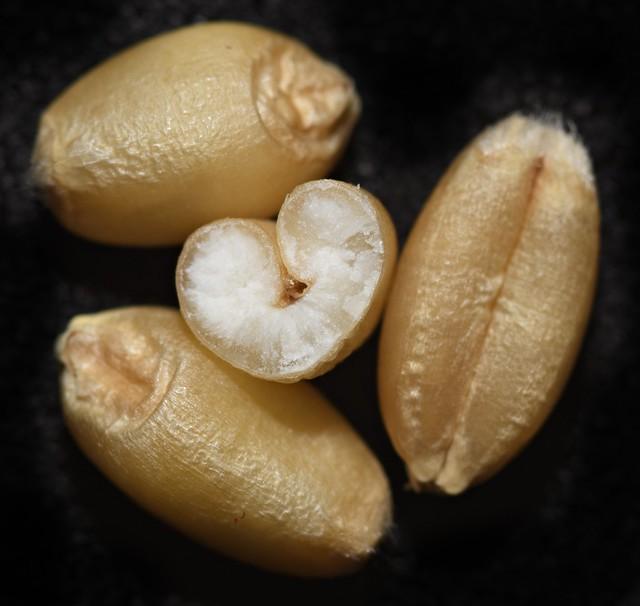I am staring at almost 2 kg of Kernza branded perennial wheat
https://landinstitute.org/our-work/perennial-crops/kernza/
and trying to figure out what to do with this preciou$ $tuff ($$$ but this is my kind of shopping therapy) to really figure out what it can do. I am thrilled to try a perennial wheat crop, so much potential (carbon capture! low/no till! so many benefits!), although these little tiny kernels do make me a bit wary. It's so small, and clearly has a much smaller surface to volume ratio than durum, spelt, emmer, einkorn, hard red or soft white wheats.
Here's the Kernza, including one cut in half for a view of the endosperm:

And here is durum wheat, not to same scale:

Hard Red Fife Wheat, ditto

And plump soft white wheat, ditto

I went a bit crazy today and shot all the grains I had in the pantry at present...usually there's millet too but must have run out. I made a flickr album with very up-close macros of all of them.

It's baking qualities will likely be quite distinctive:
QuoteThinopyrum intermedium, known as intermediate wheatgrass (IWG), is one of several perennial crops available for potential food use. The overall objective of this work was to investigate the chemical, functional, and baking properties of wholegrain flour obtained from the grains of 16 IWG breeding lines. Compared to wholegrain wheat flours, IWG wholegrain flours had higher protein, dietary fiber, and ash, yet were lower in starch content and deficient in high molecular weight glutenins. The ratios of amylose to amylopectin among the wholegrain flours of IWG and wheat were similar, but IWG flours exhibited lower viscosity during heating and cooling. Dough from IWG flour had lower stability, resistance to extension and extensibility compared to dough from wheat flour. While bread from IWG flour had similar specific volume to one of the wheat flours, it had lower rising capability due to weaker gluten network forming ability. Although IWG flour might not be ideal for bread products that require rising properties, results indicated that it could be suitable for other applications.
(*)
And this Civil Eats article describes some things to watch out for, but it's hard to know if the wheat I've got is the same as was being discussed in 2015:
Quote
Zachary Golper, baker and owner of the bakery Bien Cuit in Brooklyn, made test batches of bread with 40 pounds of whole grain Kernza flour. While the protein content is higher–20g as opposed to 16g–its ratio of gliadin and gluten is very far off from wheat, making it difficult to apply standard recipes....Golper first made a plain hockey puck out of 100 percent Kernza. Then he let it ferment for over 24 hours in a warm environment, where it became extremely bitter. So Golper tried a basic method for low acidity, and started to get interesting results. “I could taste the grain in a way that I’m not sure anyone has. It speaks of an old grass flavor. But I found that there was this thing–sort of a metallic taste–I couldn’t eliminate.”
....Beyond bread, Kernza is also appearing in whiskey. Ventura Spirits, a California-based spirit company known for using unique ingredients has picked up the grain for it’s dual value: taste and environmental impact. Henry Tarmy, one of the partners at Ventura Spirits, says the grain has a surprising bouquet–floral, light, and almost fruity–even straight off the still. “We started experimenting with it because it’s exciting to be part of a work in progress and in some small way we can help usher in commercial viability. But then we found out, well shit, this stuff is really delicious,” Tarmy says.
Metallic taste would be unpleasant, but I've been playing a lot with gluten-free baking because of a friend's Celiac diagnosis, so this is not necessarily a major problem for cookies, cakes, pancakes, muffins, scones, crackers, and flatbreads, because flax and chia do wonders to stick stuff together....and certainly not an issue for soups. And this stuff has such an intoxicating sweet and spicy scent when I opened the package that I could hardly believe it until I had decanted the packages into a glass jar and left them overnight--and the scent is still there.
I don't have 40 lbs to play with, but I've got mills and lots of practice mixing and matching grains to recipes. I'm thinking first a plain crisp flatbread or cracker (flour/water/bit of butter or oil/salt/ammonium carbonate (to keep them from being like rocks)); a simple cookie or scone without a lot of fruit, nuts, spices; something like zuppa di farro to enjoy it cooked whole.....and making each of these in small quantities, in parallel with 1-2 other wheats to compare.
*Version of Record: https://www.sciencedirect.com/science/article/pii/S0733521018303771 Manuscript_d9bd1455f820fb61bf71577f53554980
Chemical characterization, functionality, and baking quality of intermediate wheatgrass (Thinopyrum intermedium)
1121 Citra P. Rahardjo , Chathurada S. Gajadeera , Senay Simsek , George Annor ,
1 1,3,* 1,* Tonya Schoenfuss , Alessandra Marti , Baraem P. Ismail
1
2
3
Department of Food, Environmental and Nutritional Sciences, Università degli Studi di Milano, Milan, Italy
*A. Marti: Department of Food, Environmental and Nutritional Sciences, Università degli Studi di Milano, Via G. Celoria 2, 20133 Milan, Italy; email: alessandra.marti@unimi.it
*B. P. Ismail: Department of Food Science and Nutrition, University of Minnesota, 1334 Eckles Avenue, Saint Paul, MN 55108, U.S.A; email: bismailm@umn.edu
Department of Food Science and Nutrition, University of Minnesota, Saint Paul, MN, U.S.A
Department of Plant Sciences, North Dakota State University, Fargo, ND, U.S.A
Keywords: perennial crop; Thinopyrum intermedium; chemical and functional characterization; baking quality
1
© 2018 published by Elsevier. This manuscript is made available under the Elsevier user license
https://www.elsevier.com/open-access/userlicense/1.0/



